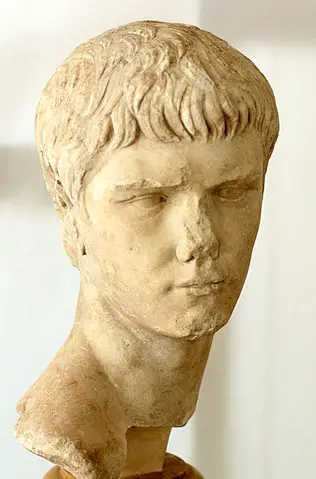Julio-Claudian Dynasty
The Julio-Claudian Dynasty was the first imperial dynasty to rule the Roman Empire. Some historians believe the dynasty was started by Julius Caesar when he became dictator for life. Ultimately Octavian, Caesar’s adopted son was the first Roman Emperor. Octavian secured the title of Augustus after defeating the enemies of Julius Caesar in a brutal civil war in Rome.
Augustus was then succeeded as emperor by his adopted son named Tiberius. His great-grandson named Caligula was next. Caligula was followed by Augustus’ great-nephew named Claudius.

The last Roman Emperor of the Julio-Claudian Dynasty was named Nero, who was adopted by Claudius. In total, the Julio-Claudian Dynasty ruled the Roman Empire from 27 B.C.E. until 68 C.E.
Formation of the Julio-Claudian Dynasty
Ancient Romans were very interested in family lineage or where their families came from. The Claudian’s were one of the oldest families in ancient Rome. The Julian family was thought to trace back to Julius Caesar and ultimately to Aeneas, a mythical ancestor to Romulus and Remus as well as Venus, the goddess of love.
The first time the two families were brought together was when Augustus married Livia Drusilla, his third wife. The Julio-Claudian Dynasty became secure with the marriage of Germanicus, a Claudian to Agrippina the Elder, a Julian.
Roman Emperors
Augustus was the first Julio-Claudian Roman Emperor. He reigned from 27 B.C.E. until 14 C.E. His birth name was Octavian. He was the adopted son of dictator-for-life Julius Caesar. He was part of the Second Triumvirate.
After defeating his rivals in a civil war, he became the first Roman Emperor of the Roman Empire. Augustus installed Roman Peace or Pax Romana, which was a peaceful time throughout the Roman Empire. He built numerous buildings, theaters, aqueducts, and temples, including Augustus’ Altar of Peace.
Tiberius was the second Roman Emperor. He was the son of Augustus’ third wife, Livia. Most historians believe Tiberius did not want to be an emperor. He reigned from 14 C.E. until 37 C.E. He left a man named Sejanus in charge of Rome.
Sejanus began a series of treason trials against his enemies. Tiberius spent most of the time as emperor on the Island of Capri. He would eventually return to Rome and execute Sejanus while emperor Tiberius married his stepsister Julia who was the only daughter of Augustus.
Caligula was born a true member of the Julio-Claudian Dynasty and the third Roman Emperor. He gathered the name of Caligula, which translates to Little Boots while following his father on military campaigns dressed as a small soldier.
His father was a famous general named Germanicus. His mother was Antonia Minor, the daughter of Marc Antony. He was the great-nephew of Augustus and married the granddaughter of Augustus. He ruled the Roman Empire from 37 C.E. until his death in 41 C.E. During his reign of the Roman Empire, Caligula is thought of as a bad leader.
He threw lavish parties. He spent considerable amounts of money on his lifestyle. He also held treason trials, including exiling his sister Agrippina the Younger. He was unable to conquer Britannia. He did, however, build new aqueducts and theaters. Caligula was assassinated by his own Praetorian Guard.
Claudius was the fourth Roman Emperor of the Julio-Claudian Dynasty. He was the brother of Germanicus and Tiberius. He ruled from 41 C.E. until his death in 54 C.E. As a child, he stuttered, had a limp, and drooled. As the Roman Emperor, he expanded the Roman Empire by invading Britannia, Thrace, Noricum, Mauritania, and Lycia.
He brought a relative peace to Rome again. Unfortunately, he also had treason trials and executed more than 35 Roman Senators. He was poisoned by his wife named Agrippina the Elder, the sister of Caligula.
Nero was the fifth and last Roman Emperor of the Julio-Claudian Dynasty. He ruled from 54 C.E. to 68 C.E. when he committed suicide. He is best remembered for watching Rome burn, although he was not in the city at the time.
He was kind to the people early in his reign. He also restored many of the Senate’s powers. He was instrumental in providing the public with chariot races, concerts, plays, large gladiatorial contests, and reduced taxes.
Important facts about the Julio-Claudian Dynasty
- The Julio-Claudian Dynasty provided the Roman Empire in the first five emperors.
- The Julian family traced their roots to Julius Caesar and Romulus and Remus, the mythological founders of ancient Rome.
- The Claudian family was a prominent aristocratic family in Italy.
- Some historians believe that Julius Caesar was the first emperor when he declared himself dictator-for-life.
- Augustus was the first Julio-Claudian Dynasty Roman Emperor. He installed the Roman Peace or Pax Romana.
- Claudius was perhaps the next best Roman Emperor. He expanded the Roman Empire under his reign to include Britannia.
- Caligula held the throne for the least amount of time. He was assassinated by his Praetorian Guard.
- All of the Julio-Claudian Dynasty Roman Emperors could trace their roots to Julius Caesar. The dynasty was able to remain in control of the Roman Empire through adoption.
Questions
The Julian family traced their roots to which mythical figures of ancient Rome?
Romulus and Remus
Who was the first real Roman Emperor of the Julio-Claudian Dynasty?
Augustus
How did the Julio-Claudian Dynasty stay in power after an emperor died?
Adoption of family members
Which Roman Emperor from the Julio-Claudian Dynasty was able to successfully invade Britannia?
Claudius
Who was the last Roman Emperor of the Julio-Claudian Dynasty?
Nero



